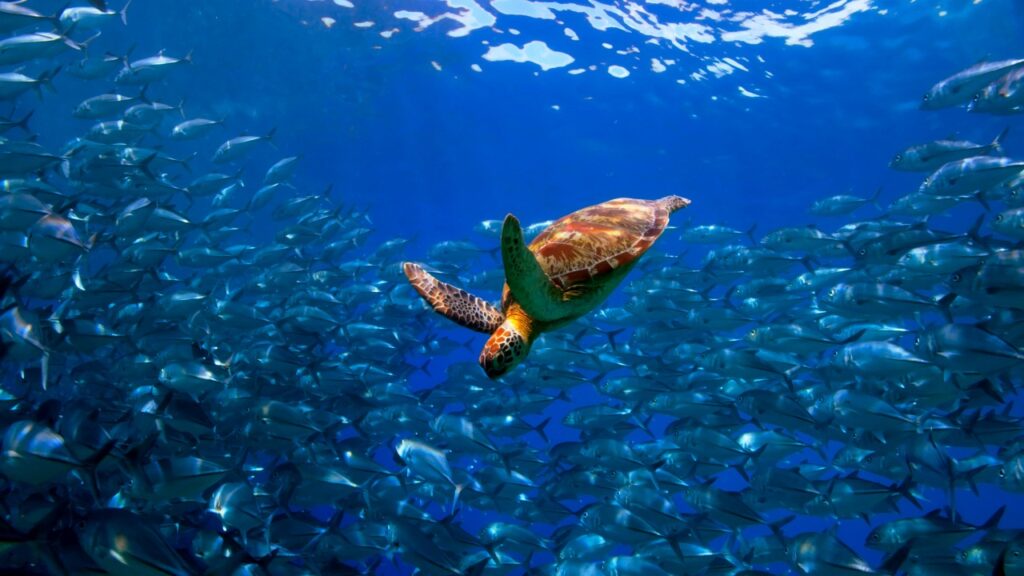

The world’s oceans are struggling to cope with warming waters, plastic pollution and overfishing.
However, one tool has emerged as a proven way to protect marine life, support coastal communities and help achieve the global 30×30 goal: Marine Protected Areas.
But what are Marine Protected Areas (MPAs), and how do they work?
Marine Protected Areas are parts of the ocean where human activity is more carefully managed or limited to conserve biodiversity and restore ecosystems.
These might include coral reefs, seagrass meadows, open waters, or coastal zones. Some are fully protected “no-take” zones, where activities like fishing, drilling, and mining are banned. Others allow limited use under strict regulations.
Although the idea has existed for decades, MPAs gained international momentum in the 1980s and 1990s, especially after the 1992 UN Convention on Biological Diversity. Since then, governments have increasingly embraced MPAs as tools to combat overfishing, habitat loss, and marine degradation.
The answer depends on their location.
National governments often designate MPAs within their territorial waters, with input from scientists, conservation groups, and local communities.
In international waters beyond any single country’s control, known as the high seas, many different bodies need to come to agreements.
MPAs can be found in every ocean and sea on Earth, from massive reserves in the remote high seas to small, locally managed areas near shorelines.
The Papahānaumokuākea Marine National Monument in the Pacific is one of the largest in the world, spanning over 1.5 million square kilometres. While the UK currently has over 370 MPAs, covering around a third of its waters.
But size alone doesn’t determine effectiveness. What matters is where these MPAs are placed and how well they’re managed.
From remote coral reefs to nearshore seagrass meadows, a truly effective MPA network includes a variety of ecosystems across different regions. This diversity helps ensure that a wide range of species and habitats are protected.
The ocean covers more than 70% of the planet, yet only about 8% is designated as Marine Protected Areas, and just 3% is fully protected from extractive activities. Overfishing, pollution, habitat destruction, and climate change are driving marine species to the brink.
One of the most destructive practices, bottom trawling, is often still permitted in less managed areas. The urgency of banning such activities is spotlighted in the documentary Ocean by David Attenborough. The film, co-produced by Pristine Seas, reveals the shocking damage bottom-trawling causes, but also demonstrates how areas of ocean with the proper protection can be restored.
MPAs offer a lifeline. They create safe havens where marine life can recover and thrive.
Well-managed MPAs can lead to larger fish populations, greater biodiversity, and more resilient ecosystems. The benefits often extend beyond their borders too, boosting fish stocks nearby through what’s known as the “spillover effect.”
MPAs aren’t just conservation tools, they’re vital for sustainable development. Just ask 2023 Earthshot Prize Finalist Coastal 500.
MPAs are typically managed through a combination of zoning rules, patrols, monitoring, and community involvement. What is allowed depends on its level of protection, for example fishing, tourism, and research might be permitted under certain conditions.
What is not allowed varies too. In strict no-take zones, environmentally damaging activities like commercial fishing, mining, and oil exploration are banned entirely. In more flexible MPAs, the focus is on regulating activity rather than prohibiting it.
Managing MPAs takes a coordinated effort. Government agencies, scientists, rangers, and local communities all play a role in keeping these areas protected. Day-to-day operations might involve patrolling by boat, tracking changes with satellite or underwater sensors, and removing illegal fishing gear.
In better-resourced areas, technology like drones and AI tools are making monitoring faster and more precise, helping teams spot problems and respond quickly. It’s a mix of local knowledge, high-tech tools, and long-term commitment that keeps these areas functioning.
Proven to protect biodiversity and sustain ocean health at scale, MPAs are among the most effective tools we have for reaching the global “30×30” goal of safeguarding 30% of land and sea by 2030.
Today, just over 8% of the ocean is designated as an MPA, with new areas being added all the time.
While creating new MPAs remains essential, there’s also growing momentum to strengthen the ones we already have by using technology to make protection smarter, stronger, and more effective.
To truly make progress towards the 30×30 goal, MPAs need to be enforced, inclusive, and backed by long-term funding and community trust.
When that happens, the science is clear: ocean life rebounds, ecosystems recover, and communities thrive alongside a healthier sea.